Categories: Featured Articles » Sharing experience
Number of views: 65097
Comments on the article: 1
What to do if the chandelier does not work
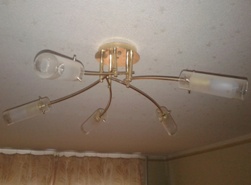 You go into the room, turn on the switch, but the chandelier does not light up, even though the lamps are intact and in place. Before buying a new chandelier, you need to check everything, maybe the switch does not work or the contact has oxidized somewhere.
You go into the room, turn on the switch, but the chandelier does not light up, even though the lamps are intact and in place. Before buying a new chandelier, you need to check everything, maybe the switch does not work or the contact has oxidized somewhere.
When troubleshooting, it should be remembered: in Soviet times, wiring was often done so that the switch interrupted the neutral wire, according to modern requirements, the switch must necessarily break the phase wire. Therefore, today in the apartments there are both options, which can cause additional difficulties.
For example, take a chandelier with two groups of lamps, each of which is turned on by its own switch button (Fig. 1).
If all the lamps do not work, therefore, a malfunction should be sought in the general part of the circuit for both groups of lamps. And this is the section from the box to the switch (section 1-2), from the box to the lamps (section 6-8) and the switch itself.
It’s best to start with the switch, because the easiest way to get to it. To do this, remove the keys and the decorative frame, which is easily done with indicator screwdriver. We have three terminals (points 2,3 and 4), one of which is located opposite the other two and is a lead (Fig. 2).
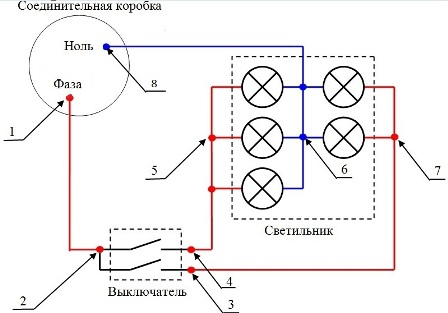
Figure 1 - Schematic diagram of the connection of the switch and the chandelier with interruption of the phase wire
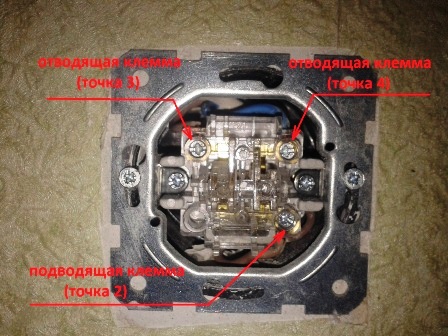
Figure 2 - Switch Terminals
Having turned off the switch, using an indicator screwdriver, check the phase at the supply terminal (point 2). Its presence means that we have a circuit with a phase wire interruption shown in Fig. 1 and the wire from the box to the switch is intact (section 1-2).
Having turned on the switch, we check the phase at the outgoing terminals (points 3 and 4), its presence means that the switch is working.
Having removed the base of the chandelier, we find three twists or a terminal block with three terminals under it (Fig. 3).
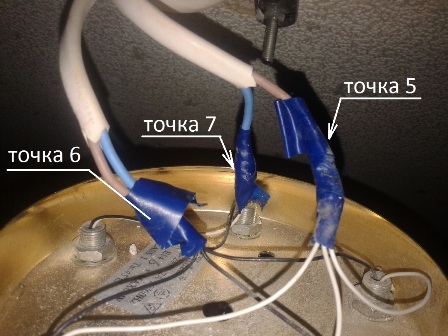
Figure 3 - Groups of chandelier lamps
Having turned on both keys of the switch, we will check the voltage between points 5,7 and 6. If there is voltage, replace the chandelier. Otherwise, touch each of the contacts with an indicator screwdriver, if there is a phase on all of them, then the zero wire from the box to the chandelier is faulty (6-8). Sometimes it breaks at the exit from the ceiling, less often the contact in the box or the contact on the chandelier is oxidized. If there is no phase on all three terminals, then the wires from the switch to the lamp groups are faulty (section 3-7 and section 4-5), which is rare.
Now we consider the case if there is no phase on the supply terminal (point 2) of the switch, in its off state. But at the same time there are phases on the outgoing terminals (points 3 and 4), this means that we have the circuit shown in Fig. 4.
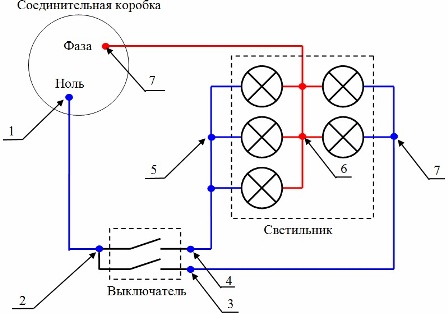
Figure 4 - Schematic diagram of the connection of the switch and the chandelier with the interruption of the neutral wire
It is necessary to remove and ring the switch, if it is working, then the neutral wire from the box to the switch is damaged (section 1-2). First of all, you need to look at the exit from the wall into the socket and in the junction box.
If there is no phase on all three terminals (points 2,3,4), when the switch is off, then the phase wire is damaged, regardless of the connection diagram.We recommend reading:How to find phase and zero using an indicator screwdriver or multimeter
To understand it to the end, you can turn on the switch, take the working phase from the outlet and measure the voltage between it and the terminals of the chandelier (points 5,6,7). If voltage appears in one of the three cases, the phase wire from the box to the switch is damaged. If voltage appears in two of the three cases, the phase wire from the box to the chandelier is damaged.
It should be noted that during installation the wires are not laid from the switch directly to the chandelier (section 4-5 and 3-7), but pass through the junction box.
If a wire malfunction is found in any area, you should look at the places where it exits the walls, it is there that it most often breaks.
See also on this topic:How to repair a Chinese chandelier - the story of one repair
See also at e.imadeself.com
:
